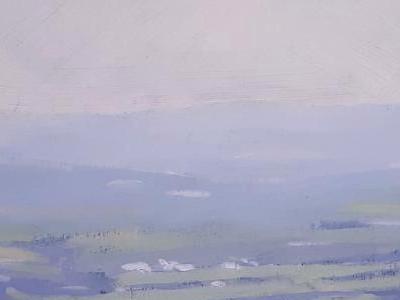What strikes me about revisiting 19th Century art history is that there is so much more going on than the linear art history from only a few decades ago, and this re-evaluation continues into the 20th century. There are a lot of streams and tendencies going on.
But returning for now to the more familiar story, there is a lot more happening before the Impressionists came along, and they certainly had their groundwork done for them before their first show of independents. Turner, already mentioned is a true one-off and so is Friedrich, but Constable also did radical work with a free brush stroke that pre-empts what was to follow. The school of Barbizon (Th. Rousseau, Millet, Courbet) is well-known, as are Jongkind and Corot.
What was radical about the Impressionists (Pisarro, Monet, Morisot) was that they went solo, they bypassed the conventional way of being shown and recognised, and eventually pulled it off. This independence and stubbornness in its turn led to a flowering of such different styles that it actually a misnomer to talk about the Impressionists as a style. How different can it get? Monet and Pisarro, Seurat and Toulouse Lautrec, Renoir and Degas: their styles are so different, and that is where the real significance lies. As a group they were soon overtaken by new movements for who they had opened the door.
It is worthwhile noting that despite their current popularity with the Impressionists also starts the separation between a large section of the public and modern art. This was made possible by both artists' stubbornness, the will to do their own thing, and the growing diversifying urban market. That didn't stop van Gogh from hardly selling a painting during his life.
With the post-impressionists individual radicalism and experimentation reach a peak (van Gogh, Cezanne, Gauguin) and colour explodes helped by new paints created by new chemistry. But again I'm impressed by the other movements that split off at the same time: the symbolists and art nouveau artists (Redon, Klimt) and the first noted "naieves" (Rousseau).
Early 20th century we then see an explosion of styles and movements (the Fauves, the colourists, Cubists, Futurists, Expressionists, Constructivists et al). The old art history has depicted these as a movement towards ever greater abstraction, but this is now generally seen as flawed. Basically on the continent anything goes from the early 20th Cy onwards, with Britain and the US lagging some 20 years behind. There are streams and influences running right through the age and any artist can choose what they wish to do and who they feel affinity with. There are clearly families of thought, for example conceptual art is hugely indebted to Dada, and self-taught naives like Wallis have opened up opportunities for many who followed.
I'm not even going to try and name landscape artists that followed or where they fit in. Some show cubist influences, others return to a super realism or a magical realism. The field is just to wide to capture.
One last point I would like to make however is that with the advent of Modern Art (capital letters!) a second split was created other than that between the general public and the new art movements: the distinction between art and illustration, generally with an implied hierarchy of the former being of a higher order. But when we realise that the last century's linear story of art was never real in the first place, it makes it easier to see that the format of illustration is another creative outlet for outlets, and the work created, often in mass media, is as worthy of attention as individual works hanging on gallery walls or in whichever modern format. I'm often taken aback by the quality of work created just to illustrate a one-off news paper article in a weekend magazine. Artistic diversity in a diverse market is the order of the day, and that's how it should be.
